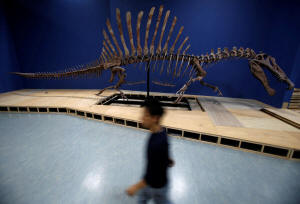Bone density study confirms watery lifestyle of 'ominous' Spinosaurus
 Send a link to a friend
Send a link to a friend
 [March 24, 2022]
By Will Dunham [March 24, 2022]
By Will Dunham
WASHINGTON (Reuters) - Spinosaurus, the
largest-known carnivorous dinosaur, and its closest relatives long have
confounded scientists trying to understand how these unusual
water-loving beasts lived their lives and hunted prey. Did they wade
into rivers and lakes like a heron? Or did they swim underwater like a
hippo or croc?
It turns out that the answer was in their bones - their bone density, to
be precise. Scientists said on Wednesday that Spinosaurus and its cousin
Baryonyx possessed extremely compact bones that would have helped them
stay submerged for underwater swimming as semiaquatic predators
targeting large prey.
Both were members of a Cretaceous Period dinosaur group called
spinosaurids that boasted anatomical adaptations such as elongated
crocodile-like snouts and conical teeth for hunting aquatic prey. But
the researchers found that another spinosaurid called Suchomimus lacked
dense bones and likely was a wading predator - showing an unexpected
degree of ecological diversity within this group.
Spinosaurus, about 50 feet (15 meters) long and weighing seven tons,
lived 95 million years ago in Africa. Its anatomy was unlike any other
dinosaur, with a relatively small pelvis, short hind legs, paddle-like
tail and feet for propulsion in the water and a curious sail-like
structure of bony spines 7 feet (2 meters) tall on its back.

"I think this animal is simply weird: we have nothing alive today that
could be considered remotely similar," said Matteo Fabbri, a
postdoctoral researcher in paleontology at the Field Museum in Chicago
and lead author of the study published in the journal Nature.
"I really like the idea of this giant animal, weighing many tons,
submerging under water to catch prey. It is striking to me that it has a
giant sail-crest on its back. That would have made it hard for it to
hide under water, but much more ominous: a bit like a shark fin poking
above the water line," said University of Oxford paleontologist and
study co-author Roger Benson.
Baryonyx, 33 feet (10 meters) long, lived 125 million years ago in
Europe. Suchomimus, 36 feet (11 meters) long, lived 120 million years
ago in Africa.
In determining that greater bone density is directly associated with an
aquatic existence, the researchers amassed data on 297 species of living
and extinct animals, land-dwellers and water-dwellers.
[to top of second column]
|

A man walks past a Spinosaurus skeleton replica during a preparation
and media preview for the Dinosaur EXPO at the National Museum of
Nature and Science in Tokyo, Japan, March 1, 2016. REUTERS/Yuya
Shino/File Photo
 Bone compactness was found to be a
defining characteristic in animals adapted for life in the water
such as whales, seals, dugongs, hippopotamuses, crocodiles, penguins
and various extinct marine reptiles. No other dinosaurs were found
with the bone density of Spinosaurus and Baryonyx, indicating they
were alone among dinosaurs in conquering the aquatic realm.
"Spinosaurus has the highest bone density among the three," Fabbri
said. "Baryonyx has a slightly lower bone density, but still very
similar to Spinosaurus. Suchomimus, found as a more terrestrial
animal in our study, has a bone density similar to other terrestrial
dinosaurs, reptiles and mammals."
Spinosaurus exceeds even Tyrannosaurus rex in size, but its anatomy
has long puzzled scientists. Its original fossils from Egypt were
destroyed during World War Two. But the discovery of a skeleton in
Morocco in 2008 and additional tail bones dug up subsequently led
some paleontologists to propose that Spinosaurus was semiaquatic and
an active swimmer. Other researchers looking at the same fossils
disagreed.
The new study was launched to try to settle the debate.
Big fish in rivers and lakes as well as dinosaurs walking along
their banks may have been appealing prey for Spinosaurus.
"Spinosaurus was perhaps moving along shallow waters using a
combination of 'bottom-walking' - like modern hippos - and lateral
strokes of its giant tail," said University of Cambridge
postdoctoral researcher and study co-author Guillermo Navalón.
"Probably used this means of locomotion not to pursue prey for long
distances in open waters but to ambush and catch very large fish
like lungfishes or coelacanths."
(Reporting by Will Dunham, Editing by Rosalba O'Brien)
[© 2022 Thomson Reuters. All rights
reserved.] This material may not be published,
broadcast, rewritten or redistributed.
Thompson Reuters is solely responsible for this content.
 |